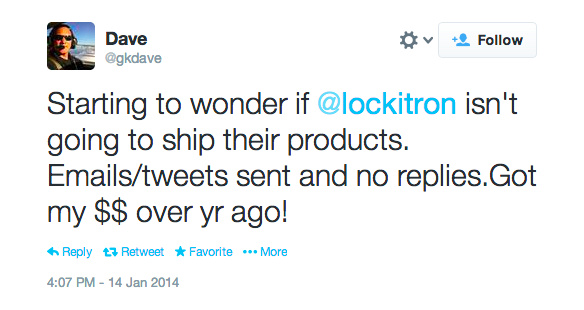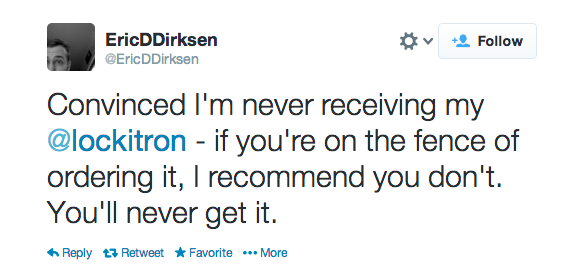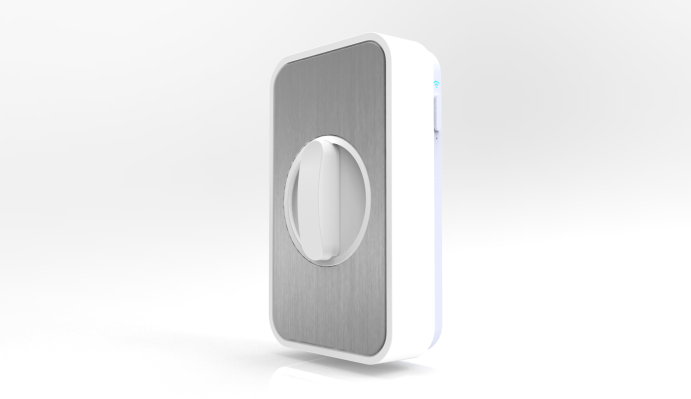YC alum Lockitron still hasn’t shipped its next-gen product to the vast majority of backers. As of right now, almost a year on from its original shipping deadline, the keyless smart lock that’s designed to fit over your dumb deadbolt so you can lock and unlock your door with a smartphone remains so much sexy-looking vapourware — for all but about 100 of its 14,704 backers.
And it’s not like Lockitron has never made product before. It actually shipped its first smart lock gizmo back in 2011 — although that was a less sophisticated version which required the owner to replace their dead-bolt (whereas the next-gen of Lockitron will apparently work with most deadbolts — or it will if it ever gets to you).
That first wave of second-gen Lockitron pre-orderers were told to expect the device in March 2013. But that shipping deadline is very out of date. Right now Lockitron’s website is saying the product “arrives” in January 2014. That’s a pretty big delay, whichever way you cut it.
Not that that’s unusual in the crowdfunding product space. Delays abound — and are almost a given when hobbyist hardware makers attempt to go pro. But Lockitron is more high profile than a lot of crowdbacked projects, raising what was a record-breaking chunk of cash via a privately run Selfstarter channel to get its product to market, and attracting reams of excited press. (Including here on TC.)
Lockitron’s road to product manufacturing has certainly had twists and turns. It was rejected by Kickstarter but went on to raise $2.2 million via Selfstarter’s crowdfunding platform. That was in October 2012. At which point the shipping schedule for Lockitron’s first batch of product was moved from March 2013 to July 2013.
But July 2013 came and went, and nearly all backers still hadn’t gotten their Lockitrons.
Backers were subsequently told to expect shipping product between October 5-10, 2013 — at which point one disgruntled backer, who contacted TechCrunch with his tale of Lockitron-less woe, decided to let the company charge his card (last October 4) in order to hopefully expedite shipment of the long-awaited smart lock.
At that point, according to the backer, it was still optional to make a payment. However, he says Lockitron did suggest that backers who opted to have payment taken then (again, we’re talking last October) would be at the front of the queue for getting the actual Lockitron product.
Yet that shipping deadline came and went and he still didn’t get his smart lock.
To Lockitron’s credit they did not collect their crowdfunded windfall en masse at the close of their Selfstarter campaign — as would typically be the case with a campaign run on platforms such as Kickstarter, for instance — but rather they said they would wait to be in a position to ship product before taking payment. Unfortunately they appear to have slipped on that pledge by encouraging backers to cough up for another phantom shipping deadline yet failing to keep their side of the bargain.
The backer who contacted TechCrunch said updates about Lockitron’s most recent shipping delays have also been few and far between — with info only forthcoming when he reached out directly to a company support email to ask where his stuff was.
In one support email sent by Lockitron to the backer in question on October 17, and see by TechCrunch, a Lockitron support staffer confirms a shipping delay — and extends the shipping date by a few more weeks, saying:
I apologize for the very slow response. We are running a bit behind with
the build process and we expect your device to ship October 21-25.
In another email — again sent only after the backer reached out directly, and this one received on January 10 — Lockitron moves the shipping goal-posts yet again, this time by a rather longer period, and without nailing themselves to a specific date:
Thanks so much for reaching out. We are running approximately 6-8 weeks behind schedule from today, not the date currently posted in your dashboard. We will update your dashboard as soon as we have a better idea as to when your Lockitron will ship.
I sincerely apologize for the delay and please know that we’re working hard to get Lockitron on your door soon.
TechCrunch contacted Lockitron co-founder Cameron Robertson to ask for an explanation on these latest lengthy delays. He confirmed the company has only shipped “about 100” Lockitrons so far, and blamed the delay on a variety of manufacturing/operation problems, and a desire to improve an unsatisfactory user experience with the early shipping Lockitrons:
Definitely – we’ve had our fair share of manufacturing and operations issues. We’ve shipped about 100 Lockitrons to date and found the initial out-of-box experience wasn’t great since we had yet to enable Bluetooth Low Energy and there is latency over unlocking via WiFi.
We’re currently pushing Bluetooth Low Energy into “beta” with folks in the field for a week or two – once that looks good and we push to app store with Bluetooth Low Energy, we’ll resume shipping on units in stock. The temptation to ship prematurely is incredibly great given the disappointment that folks have from waiting longer, however, shipping a product that isn’t complete is far worse. We have close to 1,000 units in stock (built, assembled and packaged) and are waiting on circuit boards to arrive the end of this month and be assembled here locally for a subsequent 10,000 units.
It’s worth noting that Lockitron’s shipping delays are set to continue, according to Robertson’s comments, pushing fulfilment for thousands of orders into February — and beyond. (Update: We asked Lockitron to confirm a firm shipping date for backers but they did not respond to our email. Separately, another Lockitron backer got in touch — who backed the project in October 2012 and had his card charged last year. He claimed to have tracked down and spoken to Robertson via telephone, and was told to expect his Lockitron in March 2014 — based on his positioning in the pre-order queue.)
According to updates received by the first backer who contacted TC, Lockitron has previously given its backers various explanations for shipping delays — including manufacturing issues with China, bad boards, and beta units using up the 4 AAA batteries too quickly because the unit’s Bluetooth is always on — which it is apparently trying to correct using NFC as a smart “wake up” trigger for each unit. (Albeit, he said delay explanations have been less forthcoming since last October’s deadline came and went.)
This disgruntled backer has since requested (and received) a refund after deciding he couldn’t wait any longer. Nor is he the only irate Lockitron supporter, as you’d expect given the length of delay to ship product and the large quantity of still unfulfilled pledges.


Lockitron is of course not alone as a crowdfunded project that’s failed to deliver on its estimated shipping schedule. Quite the opposite. Anyone who has pledged cash in a crowdfunding scenario knows it’s a caveat emptor situation — since the product being paid for is both unseen and also unreal. As in, it’s not actually been made yet. It’s a pre-product, so to speak.
Plus the promises makers make aren’t typically binding. So you’re putting cash down in good faith — in the hopes that a project will deliver what and when it says it will. But hey, shit happens. So delays aren’t surprising.
Very long delays, however, start to look sloppy and become rather harder to defend — especially if a project isn’t keeping backers in the loop. That’s very bad form all round. A product like Lockitron is clearly a complex proposition but the level of complexity in building it was evidently underestimated by the company in its various over-optimistic shipping estimates. Hence the ongoing issues they are having with poor user experience.
And while a few months late is one thing, going on for a full year late is quite another. That sort of delay risks undermining the entire product — being as the competitive landscape is likely to have shifted considerably over such a lengthy period, and people who might have bought rival offerings are locked in by a promise that’s not being kept.
Of course, on the flip side, crowdfunders should know full well what they are getting themselves into. There’s always a risks section on such campaigns warning that fulfilment might take longer than expected. And by implication that it might not happen at all.
Even early adopters of consumer electronics products made by huge corporations know they are risking a buggy product, as well as paying over the odds to be used and abused by calculating corporate machines that need guinea pigs to feed into their product development machines. Guinea pigs whose squeaks of outrage are used to sandpaper the rougher edges off of commercial shipping product — so a later-to-adopt mainstream gets a smoother ride.
Early adopters are the sacrificial grist to the corporate mill. But most early adopters know this all too well — meaning there can be a masochistic streak in pre-ordering and pledging merely on a promise of product.
This early adopter ‘pain/delayed-pleasure continuum’ has been extended considerably by the rise of crowdfunding platforms — which allow over-eager gadget lovers to liberally donate cash to all sorts of creators for things that don’t exist, and may only ever exist as fancy-looking sketches on a bit of paper and props in a nicely shot marketing video. (And let’s not forget what marketing really is.)
And even when a crowdfunded product actually ships — typically, as in Lockitron’s case, later than the “estimated” schedule — chances are it won’t live up to the “revolutionary” promises of the original marketing pitch any way. It’ll be ugly. Or glitchy. Or chafey. It won’t be the slick disruptor that takes a category to the next level after all. But that’s the pendulum of dream and disillusionment that product manufacturers always have to manage. (An even harder trick to pull off for smaller makers trying to do a lot with a lot less too, of course.)
In Lockitron’s case, they have had a lot of success in getting people dreaming about their product — perhaps too much success. Now the responsibility of living up to all those dreams, coupled with the dread of causing mass disappointment, is a new snarl in their long road to delivering on their product pledges.
